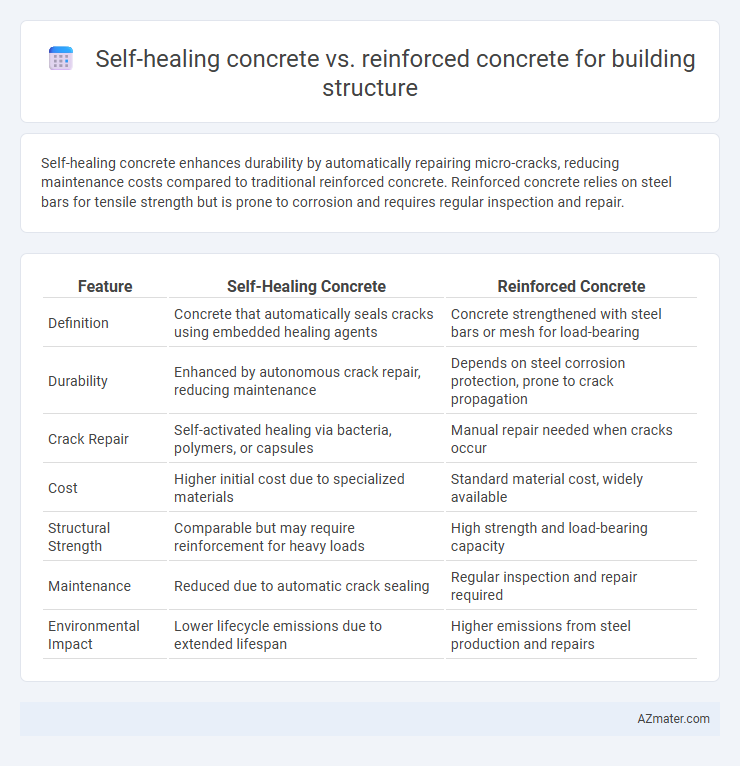Self-healing concrete enhances durability by automatically repairing micro-cracks, reducing maintenance costs compared to traditional reinforced concrete. Reinforced concrete relies on steel bars for tensile strength but is prone to corrosion and requires regular inspection and repair.
Table of Comparison
| Feature | Self-Healing Concrete | Reinforced Concrete |
|---|---|---|
| Definition | Concrete that automatically seals cracks using embedded healing agents | Concrete strengthened with steel bars or mesh for load-bearing |
| Durability | Enhanced by autonomous crack repair, reducing maintenance | Depends on steel corrosion protection, prone to crack propagation |
| Crack Repair | Self-activated healing via bacteria, polymers, or capsules | Manual repair needed when cracks occur |
| Cost | Higher initial cost due to specialized materials | Standard material cost, widely available |
| Structural Strength | Comparable but may require reinforcement for heavy loads | High strength and load-bearing capacity |
| Maintenance | Reduced due to automatic crack sealing | Regular inspection and repair required |
| Environmental Impact | Lower lifecycle emissions due to extended lifespan | Higher emissions from steel production and repairs |
Introduction to Modern Concrete Technologies
Self-healing concrete incorporates bacteria or healing agents that autonomously repair cracks, enhancing durability and reducing maintenance costs compared to traditional reinforced concrete. Reinforced concrete relies on steel bars for tensile strength, offering proven robustness but requiring regular inspection to prevent corrosion-related deterioration. Modern concrete technologies prioritize sustainability and longevity, with self-healing concrete representing a significant advancement in extending structural lifespan and minimizing environmental impact.
What is Self-Healing Concrete?
Self-healing concrete is an innovative material designed to automatically repair cracks using embedded microcapsules or bacteria that produce healing agents, enhancing durability and reducing maintenance costs in building structures. Unlike traditional reinforced concrete, which relies on steel bars to bear tensile loads and prevent structural failure, self-healing concrete actively addresses micro-cracks, minimizing water ingress and corrosion of reinforcement. This technology significantly extends the lifespan of concrete structures and improves sustainability by reducing the need for frequent repairs and material replacement.
Reinforced Concrete: Traditional Choice Explained
Reinforced concrete remains the traditional choice for building structures due to its proven strength, durability, and cost-effectiveness in large-scale construction projects. It incorporates steel reinforcement bars to enhance tensile strength, making it suitable for a wide range of structural applications including beams, columns, and slabs. Despite innovations like self-healing concrete, reinforced concrete continues to dominate owing to well-established engineering standards and extensive performance data.
Mechanisms Behind Self-Healing Concrete
Self-healing concrete incorporates bacteria or encapsulated healing agents that activate upon crack formation, producing calcium carbonate to fill and seal fissures, which enhances durability and reduces maintenance costs in building structures. Reinforced concrete relies on steel bars embedded within the concrete matrix to provide tensile strength but lacks inherent crack-repair capabilities, often requiring external intervention to address damage. The biogenic healing mechanisms in self-healing concrete extend the lifespan of buildings by autonomously mitigating microcracks and preventing corrosion of reinforcement steel.
Structural Strength Comparison
Self-healing concrete enhances structural strength by autonomously repairing microcracks, reducing maintenance costs and prolonging durability compared to traditional reinforced concrete. Reinforced concrete relies on steel bars to bear tensile loads, ensuring high load-bearing capacity but is susceptible to corrosion that weakens the structural integrity over time. Studies indicate self-healing concrete maintains compressive strength above 90% after crack repair, whereas reinforced concrete may experience strength degradation due to steel corrosion and crack propagation.
Durability and Longevity Assessment
Self-healing concrete enhances durability and longevity by autonomously repairing micro-cracks, reducing moisture ingress and mitigating corrosion of reinforcement, thereby extending the service life of building structures beyond conventional reinforced concrete. Reinforced concrete relies on steel reinforcement to bear tensile loads but is susceptible to crack-induced corrosion and degradation, which may necessitate frequent maintenance and shorter lifespan. Innovative self-healing mechanisms such as bacterial or polymer-based agents significantly improve structural integrity and reduce lifecycle costs compared to traditional reinforced concrete systems.
Maintenance Needs and Lifecycle Costs
Self-healing concrete significantly reduces maintenance needs by autonomously repairing cracks, limiting water infiltration and corrosion that commonly degrade reinforced concrete structures over time. Reinforced concrete, while strong, requires regular inspections and costly repairs due to steel reinforcement corrosion and crack propagation, leading to higher lifecycle costs. Studies indicate that self-healing concrete can extend structural lifespan by up to 30%, resulting in decreased repair frequency and overall lower maintenance expenses compared to traditional reinforced concrete.
Environmental Impact and Sustainability
Self-healing concrete reduces the need for frequent repairs, significantly lowering CO2 emissions associated with maintenance and material production compared to traditional reinforced concrete. Its ability to autonomously seal cracks enhances durability and extends the lifespan of structures, reducing resource consumption and waste generation. Reinforced concrete, while strong, often leads to environmental concerns due to steel corrosion, repair requirements, and higher carbon footprint throughout its lifecycle.
Cost Analysis: Initial and Long-term
Self-healing concrete demands higher initial costs due to advanced materials like microcapsules or bacteria embedded in the mix, whereas reinforced concrete relies on standard cement and steel reinforcement, making it more cost-effective upfront. Over the long term, self-healing concrete significantly reduces maintenance and repair expenses by autonomously sealing cracks, increasing the structure's durability and lifespan. Reinforced concrete often incurs higher lifecycle costs due to corrosion-induced damage to steel reinforcements, requiring frequent inspections and costly rehabilitation.
Future Trends in Building Structures
Self-healing concrete incorporates microcapsules or bacteria that autonomously repair cracks, significantly enhancing durability and reducing maintenance costs compared to traditional reinforced concrete. Future trends emphasize integrating smart materials and IoT sensors with self-healing concrete to enable real-time structural health monitoring and predictive maintenance. Reinforced concrete remains widely used due to its established strength, but innovations in self-healing technologies promise to extend building lifespan and improve sustainability in urban infrastructure.

Infographic: Self-healing concrete vs Reinforced concrete for Building structure
 azmater.com
azmater.com